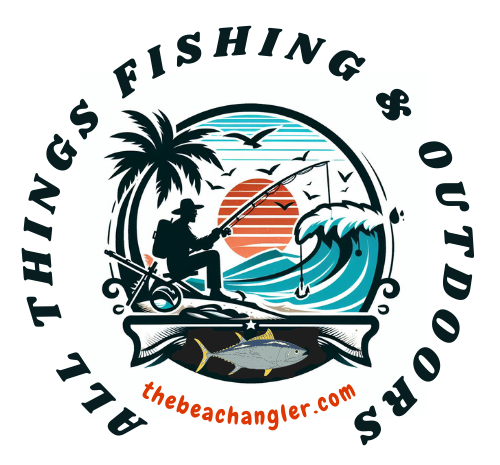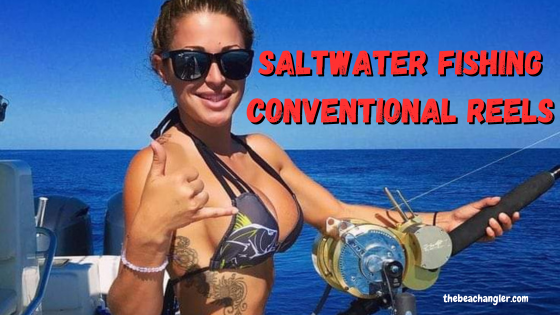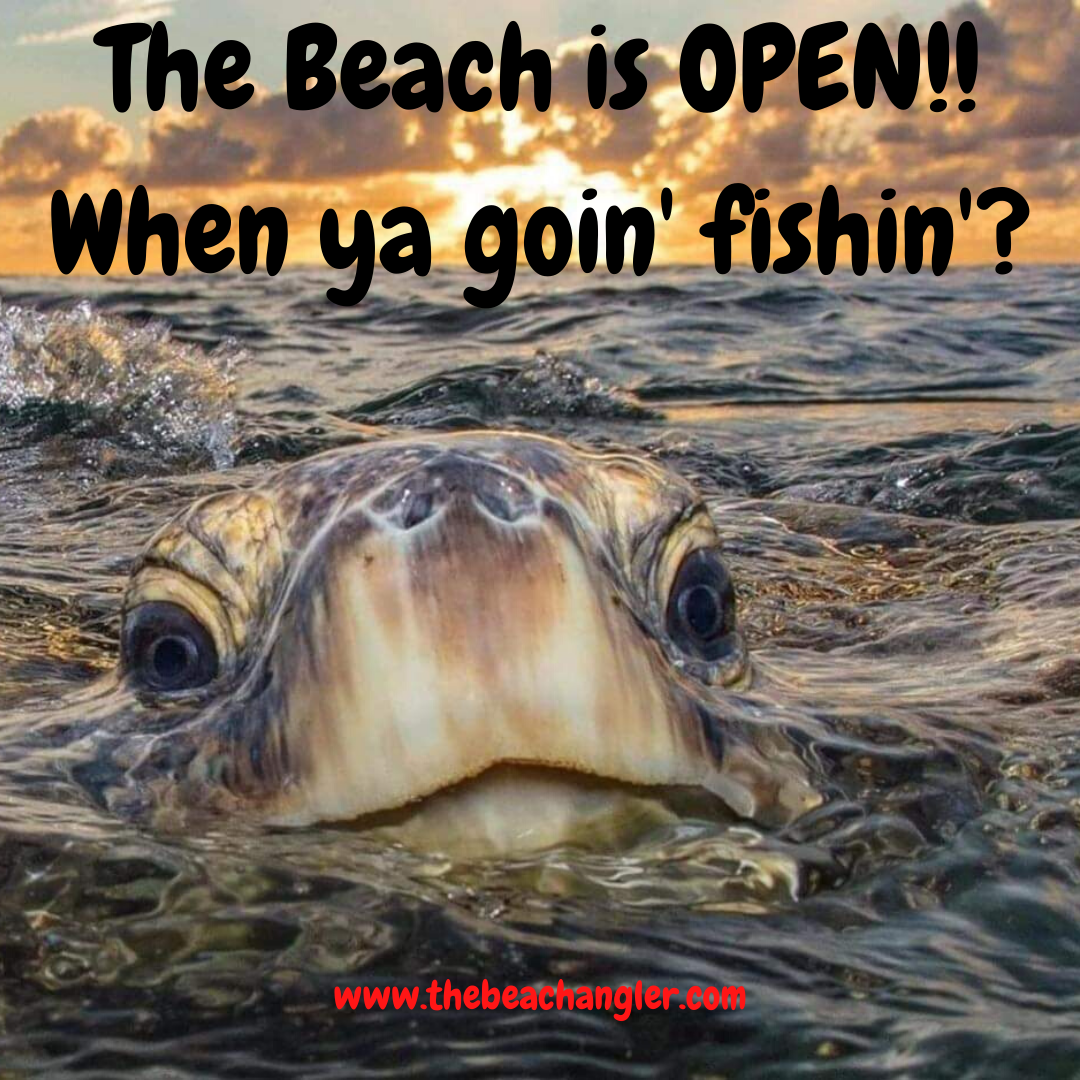If you’re an avid saltwater fisherman like me, you know that having the right equipment is essential. One of the most important pieces of equipment is your fishing reel. And, for saltwater fishing reels there is a wide variety of styles, sizes, manufactures and price ranges.
There are three main types of saltwater fishing reels: Spinning, Conventional, or Fly reels. Of course, there are variations or sub-categories of each. In this article, we’ll take a closer look at conventional saltwater fishing reels, their advantages and disadvantages, when, where, and for what they are best suited, and how to choose the right one for your needs.
Quick Look
- Saltwater fishing requires specialized equipment, including reels that are designed to handle the harsh conditions of saltwater environments.
- Conventional reels are a popular choice for saltwater fishing due to their durability, powerful drag, line capacity and versatility.
- Conventional Saltwater fishing reels are designed for big fish like marlin, sharks, mackerel and tuna offshore.
- Baitcasting Reels are a special type of conventional reel designed for long accurate casts, and are built with corrosion-resistant materials and sealed bearings to prevent saltwater damage.
Now, Since roughly seventy one percent of the earth’s surface is covered by water, it only makes sense that saltwater fishing is a popular activity for anglers around the world. However, It does require the use of some specialized equipment, including reels that are specifically designed to withstand the harsh conditions of saltwater environments.
Conventional reels, and their little brothers the baitcasting reels, are a common choice for saltwater fishing due to their strength, power, durability and versatility.
These reels mount perpendicular to, and on top of, the rod, unlike a spinning reel that mounts in parallel and underneath the rod.
They are commonly used for offshore fishing of species such as mackerel, grouper, marlin, and tuna. Tossing artificials inshore for trout, red drum, snook and flounder.
And, casting baits in the surf from the beach, jetties or piers. Saltwater conventional fishing reels are designed to handle the rigors of saltwater fishing, including the corrosive effects of saltwater on the reel’s components.

Conventional Saltwater Fishing Reels Examples:
| Trolling Reel | Baitcasting Reel | Jigging Reel | Bottom Fishing Reel |
|---|---|---|---|
 | 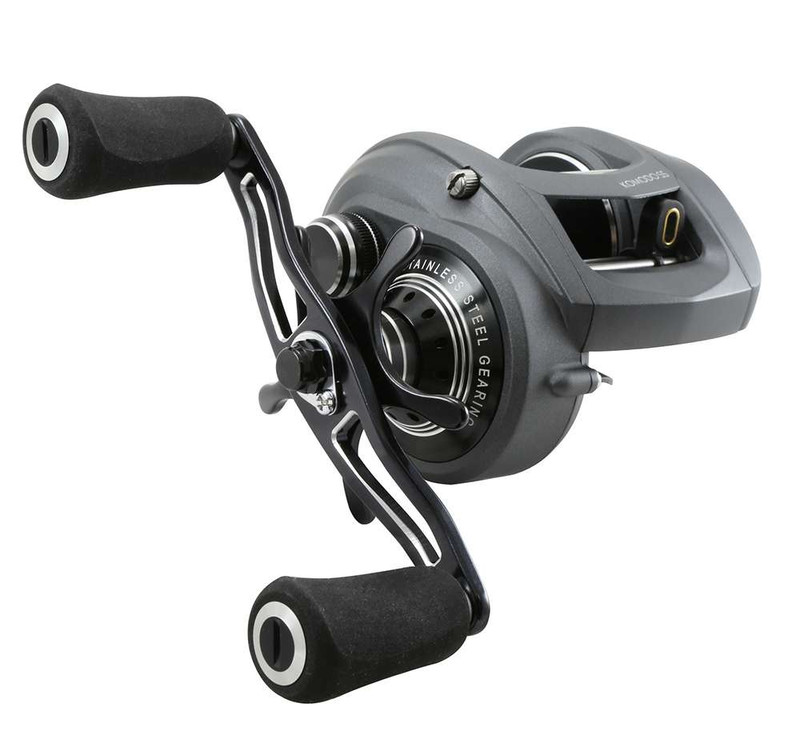 |  |  |
| Shimano TLD II | Okuma Komodo | Daiwa Saltist | Penn Senator |
| See Reviews | See Reviews | See Reviews | See Reviews |
Understanding Saltwater Conventional Fishing Reels
What Are Conventional Saltwater Fishing Reels?
Conventional reels have a fixed spool that is mounted on top of the rod, and they use a revolving handle to wind the line onto the spool. These reels can be either left- or right-handed, but most anglers prefer to use a right-handed reel. They are designed to handle heavier lines and lures, making them perfect for catching larger fish.
When it comes to saltwater fishing, conventional reels are a popular choice among anglers. Standard conventional saltwater fishing reels, also known as baitcasting or trolling reels, are designed for catching large fish in deep water and are the reel of choice when offshore fishing for species such as marlin, sailfish, and tuna.
Unlike spinning reels, which mount parallel to the rod, conventional reels mount perpendicular to it. This allows anglers to apply more pressure when reeling in large fish. These reels are built for heavy-duty cranking power, think of a winch where you are applying direct pressure from the reel to the fish as you wind the line onto the reel.
What Types of Fishing are Conventional Reels Designed for?
Conventional saltwater fishing reels are versatile and can be used for a variety of fishing techniques. Here are some of the uses of conventional saltwater fishing reels:
- Baitcasting: Conventional reels are ideal for baitcasting. They provide direct drive while also communicating more of the line’s vibrations, allowing the angler to know what’s happening based on feel. This makes them ideal for catching fish in deep water or around structures like reefs or wrecks.
- Jigging: Conventional reels are also great for jigging. They allow anglers to apply more pressure when reeling in large fish, making them ideal for catching large fish in deep water.
- Deep Dropping or Bottom Fishing: Conventional reels are commonly used for deep dropping. They are designed to handle large fish in deep water and have a lower gear ratio than spinning reels, which allows anglers to apply more pressure when reeling in large fish.
- Trolling: Conventional reels are ideal for trolling and bottom fishing, especially with offshore giants like wahoo and sailfish. They can be used for casting, live-lining, and other methods too.
What to Look for in a Saltwater Fishing Conventional Reel?
When choosing a saltwater conventional fishing reel, there are a few things to consider:

- Line capacity is an important factor, as you want to make sure the reel can hold enough line for the type of fishing you will be doing.
- A powerful drag system is also essential, as it will help you reel in larger fish without the line breaking.
- Corrosion-resistant materials are also important, as saltwater can be harsh on fishing gear. Look for reels made from materials such as stainless steel or aluminum, as these will hold up well in saltwater environments.
- How you will be fishing. Casting lures, bottom fishing, trolling, jigging or casting baits in the surf?
- What you will be fishing for. Trout, reds and flounder in the bay. Or, marlin, tuna and sailfish offshore?
Some of the best conventional reels for saltwater fishing include the Shimano Tyrnos, Penn Squall, Piscifun Salis, and Okuma Makaira. These reels offer high-performance specifications without the premium price tag.
What are the Advantages of Conventional Saltwater Fishing Reels?
One of the biggest advantages of conventional saltwater fishing reels is their power. They are designed to handle large fish in deep water. They also have a lower gear ratio than spinning reels, which allows anglers to apply more pressure when reeling in large fish.
Another advantage is their accuracy. Because they mount perpendicular to the rod, anglers can cast with greater accuracy than with spinning reels. This makes them ideal for catching fish in deep water or around structures like reefs or wrecks.
What are the Disadvantages of Conventional Saltwater Fishing Reels?
One disadvantage of conventional saltwater fishing reels is that they can be more difficult to use than spinning reels. They require more skill and practice to master. They can also be more expensive than spinning reels.
Another disadvantage is that they can be heavier than spinning reels. This can make them more difficult to handle over long periods of time.
Saltwater Conventional Reels for Trolling
When it comes to trolling, the best saltwater conventional reels are those that have a high line capacity, powerful drag system, and a fast retrieve rate. These reels are designed for big offshore fish from king mackerel to marlin and bluefin tuna. Here are some conventional reels that are great for trolling:
- Penn Squall Lever Drag Conventional Trolling Reel: This reel has a high line capacity and a powerful drag system that can handle large fish. It also has a fast retrieve rate.
- Shimano TLD 2 Speed Conventional Reel: This reel is designed for heavy-duty fishing and has a powerful drag system that can handle large fish. It also has a fast retrieve rate.
- Daiwa Saltist Levelwind Conventional Reel: This reel has a high line capacity and a powerful drag system that can handle large fish. It also has a fast retrieve rate.
- Okuma Makaira Lever Drag Reel: This reel is designed for heavy-duty fishing and has a powerful drag system that can handle large fish. It also has a fast retrieve rate.
- Avet SXJ 5.3 MC Lever Drag Casting Reel: This reel is designed for heavy-duty fishing and has a powerful drag system that can handle large fish. It also has a fast retrieve rate.
- Penn International Series Conventional Reels: These reels have long been the standard in offshore trolling reels.
| Penn Squall Lever Drag | Avet SXJ | Okuma Makaira | Penn International |
|---|---|---|---|
 |  |  |  |
| Check Price & Reviews | Check Price & Reviews | Check Price & Reviews | Check Price & Reviews |
Conventional Saltwater Fishing reels for Bottom Fishing, Jigging, or Deep Dropping
When it comes to bottom fishing, the best conventional saltwater fishing reels are those that have a high line capacity, powerful drag system, and a fast retrieve rate. For dropping baits straight down in deep water for everything from red snapper, grouper, amber jacks to sword fish. Here are some conventional reels that are great for bottom fishing:
- Penn Fathom Lever Drag: This reel has a durable construction, a lever drag system, and quick-flip, 2-speed gear ratio. It has plenty of power for hauling up big fish when bottom fishing.
- Daiwa Saltist Star Drag: This reel has a multiple gear ratio, a free spool system ideal for live baits, and a light, compact frame. It delivers in any offshore situation you might face.
- Penn Special Senator: This reel is simply constructed with a strong drag and a big line capacity. It’s a solid choice for anglers on a budget wanting to get into bottom fishing.
- Shimano Torium HGA: This reel has a high line capacity and a powerful drag system that can handle large fish. It also has a fast retrieve rate.
| Penn Fathom | Daiwa Saltist | Penn Senator | Shimano Torium |
|---|---|---|---|
 |  |  | 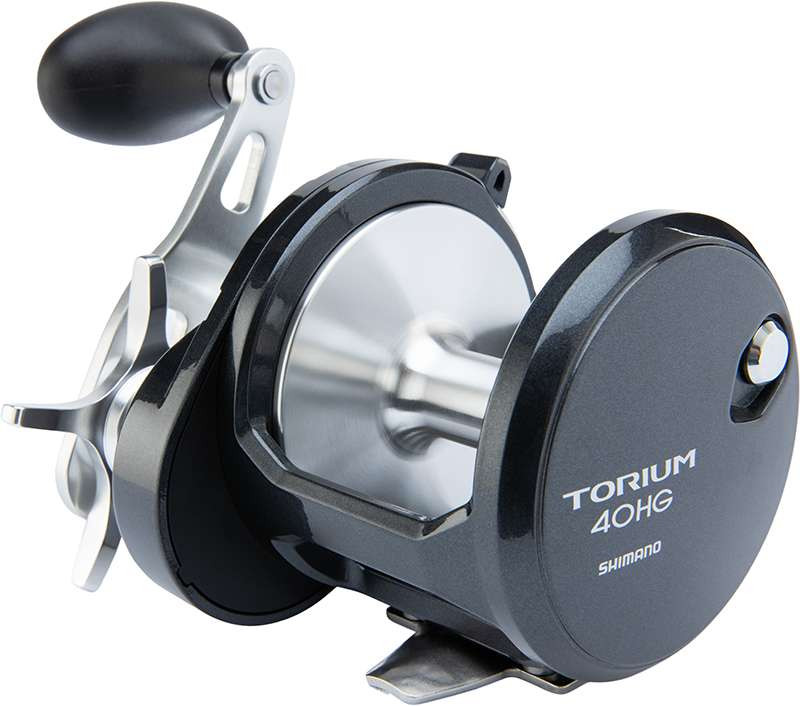 |
| Check Price and Reviews | Check Price and Reviews | Check Price and Reviews | Check Price and Reviews |
What is the Difference Between Conventional and Baitcasting Reels?
Saltwater conventional reels and saltwater baitcasting reels are both used for fishing in saltwater environments, in fact baitcasting reels are simply specialized conventional reels, but they differ in several ways.
Saltwater Conventional Reels:
- Design: Saltwater conventional reels are designed to be mounted on top of the fishing rod like baitcasting reels, but are typically larger and heavier than baitcasting reels.
- Line Capacity: Saltwater conventional reels have a larger line capacity than baitcasting reels, making them ideal for deep-sea fishing and targeting larger fish species .
- Drag System: Saltwater conventional reels typically have a stronger drag system than baitcasting reels, allowing anglers to handle larger fish species.
- Ease of Use: Saltwater conventional reels can be more difficult to use than baitcasting reels, especially for beginners. They require a certain level of skill and experience to operate effectively.
Saltwater Baitcasting Reels:
- Design: Saltwater baitcasting reels are also designed to be mounted on top of the fishing rod but are typically smaller and lighter than standard conventional reels.
- Accuracy: Saltwater baitcasting reels are known for their accuracy, making them a popular choice among experienced anglers for throwing artificial lures.
- Power: Saltwater baitcasting reels are designed to handle larger fish. They are known for their power and ability to handle heavy loads and strong runs.
- Control: Saltwater baitcasting reels offer greater control, allowing anglers to make more precise casts and control the speed of the retrieve.
- Casting: Like the name says, baitcasting reels are designed for casting where standard conventional reels are designed more for trolling, jigging or bottom fishing.

In general, saltwater conventional reels are typically larger and heavier with a greater line capacity and stronger drag system, while saltwater baitcasting reels are smaller and lighter with greater accuracy, control and castability. It’s important to consider your specific needs when choosing between these two types of saltwater fishing reels.
Advantages and Disadvantages of Saltwater Baitcasting Reels
Saltwater baitcasting reels have several advantages and disadvantages. Here are some of the most important ones:
Advantages of Baitcasting Reels:
| Advantage | Description |
|---|---|
| Accuracy: | Saltwater baitcasting reels are known for their accuracy, making them a popular choice among experienced anglers. |
| Power: | Saltwater baitcasting reels are designed to handle larger fish and they are known for their power and ability to handle the hard fights and long runs of saltwater fish. |
| Durability: | Saltwater baitcasting reels are typically constructed from high-quality materials that can withstand the harsh saltwater environment. |
| Control: | Saltwater baitcasting reels offer greater control over the fishing line, allowing anglers to make precise casts and control the speed of the retrieve. |
Disadvantages of Baitcasting Reels:
| Disadvantage | Description |
|---|---|
| Learning Curve: | Saltwater baitcasting reels can be difficult to use for beginners. They require a certain level of skill and experience to operate effectively without backlashing. |
| Price: | Saltwater baitcasting reels can be more expensive than other types of fishing reels. |
| Maintenance: | Saltwater baitcasting reels require regular maintenance to keep them in good working condition. This includes cleaning and lubricating the reel after each use. |
It’s important to consider these factors when choosing a saltwater baitcasting reel. If you’re new to fishing or don’t have much experience with baitcasting reels, you may want to consider starting with a spinning reel instead.
The Appeal of Saltwater Baitcasting Reels
Saltwater baitcasting reels are designed specifically for use in saltwater environments, where corrosion and wear can quickly damage traditional freshwater reels. These reels are built to withstand the harsh conditions of saltwater fishing, making them a reliable choice for serious anglers.
One of the biggest advantages of saltwater baitcaster reels is their pulling power. These reels are capable of handling much heavier lines and lures than traditional spinning reels, making them ideal for targeting larger fish. With a saltwater baitcaster reel, you can cast farther, fight harder, and land bigger fish than a similar sized spinning reel.
Another benefit of saltwater baitcasting reels is their precision. These reels allow for much greater control over your casts and retrieves, allowing you to place your bait or lure exactly where you want it and work it in a way that will entice even the most finicky fish. This precision can be especially important when fishing in areas with heavy cover or structure, where accuracy is key to catching fish and avoiding snags.
Remember, it’s important to look for models that are specifically designed for use in saltwater environments. These reels will typically feature corrosion-resistant materials and components, as well as advanced drag systems that can handle the intense pressure of saltwater fishing.
Overall, if you’re serious about saltwater fishing, a baitcasting reel is a must-have piece of equipment to have in your tackle arsenal. With their power, precision, and durability, they are a reliable choice for saltwater anglers who want to take their fishing to the next level.
Features of a Good Saltwater Baitcasting Reel
When it comes to choosing the best saltwater baitcasting reel, there are a few key features that you should look for. Here are some of the most important features to consider:
Corrosion Resistance: Saltwater is incredibly corrosive, which means that any fishing gear used in saltwater needs to be able to resist rust and corrosion. Look for reels that are made from high-quality materials such as stainless steel or aluminum, which are naturally resistant to corrosion.
Drag System: The drag system is one of the most important features of a saltwater fishing reel. It allows anglers to apply pressure to a fish without breaking the line. There are two types of drag systems: star drag and lever drag. Star drag systems are easier to use but less precise than lever drag systems. You need a reel that can handle the power and speed of saltwater fish, and that means having a strong and reliable drag system. Look for reels with a carbon fiber drag system, as these tend to be the most powerful and durable.
Line Capacity: Line capacity refers to how much line a reel can hold. The more line a reel can hold, the better it will perform when catching large fish in deep water. When fishing in saltwater, you never know what you might hook. That’s why it’s important to choose a reel with plenty of line capacity. Look for reels with a large spool and high line capacity, so that you can handle even the biggest fish.
Gear Ratio: The gear ratio determines how quickly you can retrieve your line. A higher gear ratio means you can retrieve your line more quickly. A lower gear ratio means you can apply more pressure when reeling in large fish. In saltwater fishing, you need a reel with a fast gear ratio, as saltwater fish tend to be fast and powerful. Look for reels with a gear ratio of at least 6:1.
Anti-Backlash System: Ah the Backlash or birds nest, a common problem when using baitcasting reels, it can be one of the most frustrating experiences in fishing. Look for reels with an anti-backlash system, which will help prevent tangles and bird’s nests.
Durability: Saltwater fishing can be tough on gear, so you need a reel that is built to last. Look for reels with a solid construction and high-quality components, such as sealed and corrosion resistant bearings and gears. A durable reel will not only last longer, but it will also perform better over time.
By considering these key features, you can choose the best saltwater baitcasting reel for your needs. Whether you’re a seasoned angler or just starting out, investing in a high-quality reel will help you catch more fish and enjoy your time on the water.
10 Top Saltwater Baitcasting Reels
The following are 10 of the top Saltwater Baitcasting Reels available on the market, with each having its unique features and benefits. The best saltwater baitcasting reels are designed to handle large fish and long casts, making them ideal for inshore or offshore fishing. They are also built to withstand the harsh saltwater environment, with corrosion-resistant materials and sealed bearings to prevent saltwater from entering the reel’s internal components.
When it comes to saltwater fishing, having the right reel can make all the difference. Baitcasting reels are a popular choice among anglers, as they offer a high level of precision and control. Here are the top 10 saltwater baitcasting reels to consider for your next fishing trip:

Shimano Calcutta Conquest DC: This reel is a top-of-the-line option that offers excellent casting distance and accuracy. It also features Shimano’s Digital Control braking system, which helps prevent backlash and allows for easy adjustments. See Pricing and Reviews.

Daiwa Saltist: This reel is built to handle heavy saltwater fish, with a maximum drag of up to 25 pounds. It also has a corrosion-resistant design to withstand the harsh saltwater environment. See Pricing and Reviews.

Abu Garcia Revo Toro Beast: With a maximum drag of up to 30 pounds, this reel is built to handle some of the biggest saltwater fish out there. It also features a durable construction and a comfortable grip for extended use. See Pricing and Reviews.

Penn Squall Low Profile: This reel is a great option for anglers who want a high level of control over their fishing line. It features brass gears, stainless steel bearings, magnetic casting brake, and a smooth drag. See Pricing and Reviews.

Okuma Komodo SS: This reel offers a high level of power and precision, with a maximum drag of up to 30 pounds. It also has a corrosion-resistant design and a comfortable grip for extended use. See Pricing and Reviews.

Lew’s Mach Crush Speed Spool SLP: This reel is designed for fast and accurate casting, with a high-speed gear ratio and a smooth drag system. It also has a lightweight design for easy handling. See Pricing and Reviews.

KastKing Royale Legend GT: This reel is a budget-friendly option that still offers a high level of performance. It features a magnetic braking system and a corrosion-resistant design. See Pricing and Reviews.

Piscifun Phantom X: This reel is built for speed, with a high-speed gear ratio and a smooth drag system. It also has a lightweight design for easy handling. See Pricing and Reviews.

Quantum Smoke HD PT: This reel offers a high level of precision and control, with a magnetic braking system and a smooth drag. It also has a durable construction and a comfortable grip. See Pricing and Reviews.

13 Fishing Concept Z: This reel features a unique design that eliminates the need for ball bearings, resulting in a smoother and more durable performance. It also has a high-speed gear ratio and a comfortable grip for extended use. See Pricing and Reviews.
Overall, these are 10 of the top saltwater baitcasting reels to consider for your next fishing trip. Whether you’re targeting big game fish offshore or casting artificials in the bay, these reels offer the performance and precision you need to succeed.
How to Maintain Your Saltwater Fishing Conventional Reels
Maintaining your saltwater fishing reel is essential to ensure its longevity. Here are some tips on how to maintain your conventional saltwater fishing reel:
- Spray down: After a day of fishing, rinse your reel with freshwater to remove salt spray, sand, and grime. Avoid using soapy water as it can break down the oil and grease meant to protect the reel. A gentle freshwater soak will remove almost 100% of the salty grime. Follow this up with a quick spray of reel oil to displace any remaining water and further protect the reel.
- Pack it up: During the off-season or just prior to use, pack the insides of the reel with a fair amount of reel grease which will form a barrier to saltwater intrusion. This helps protect and prevent further corrosion as long as the reel is not washed with soap.
- Service your reel: At the end of the season, either do-it-yourself or have the reel properly serviced by a local tackle dealer. Most tackle shops will indicate which reels they service and always use a reputable shop.
- Choose quality: Not all reels are created equal. Reel manufacturers have become more cost-efficient in some areas of reel production, which can lead to issues for long-term durability based on the materials and alloys used. It is best to talk to your local shop about the quality and durability of a prospective reel.
Conventional Saltwater Fishing Reels: Frequently Asked Questions

What is a saltwater conventional reel?
A saltwater conventional reel is a type of fishing reel that is designed for use in saltwater environments. These reels are typically made from corrosion-resistant materials and are built to withstand the harsh conditions of saltwater fishing.
What is a conventional fishing reel?
A conventional fishing reel is a type of fishing reel that is designed to be mounted on top of a fishing rod. These reels are typically used for baitcasting and trolling and are popular among both freshwater and saltwater anglers.
Can I use a conventional reel for surf fishing?
Yes, you can use a conventional reel for surf fishing. However, you will need to make sure that you choose a reel that is specifically designed for this type of fishing. Look for a reel that has a high line capacity and a strong drag system.
What kind of reel do you need for saltwater fishing?
For saltwater fishing, you will need a reel that is specifically designed for use in saltwater environments. Look for a reel that is made from corrosion-resistant materials and has a strong drag system.
What are some left-handed conventional saltwater reels?
Some popular left-handed conventional saltwater reels include the Shimano Talica II, the Penn Squall Lever Drag, and the Daiwa Saltist Levelwind.
What are some good conventional reel combos?
Some good conventional reel combos include the Penn Squall Lever Drag Combo, the Shimano TLD II Speed Combo, and the Okuma Cedros CJ-65S Combo. These combos are designed to provide anglers with a high-quality reel and rod that are perfectly matched for optimal performance.
Saltwater Fishing Reels Conventional or baitcasting: Final Thoughts
Conventional saltwater fishing reels are an essential piece of equipment for any serious angler. They offer power, accuracy, and durability that cannot be matched by other types of fishing reels. They are the standard for offshore bottom fishing, jigging and trolling. For inshore fishing the conventional, or baitcasting reels, are popular for their power, accuracy and castability.
If you’re targeting big fish offshore, or in the surf, conventional saltwater fishing reels are hard to beat.
And, if you are a land based shark fisherman, they are a necessity for their power and line capacity you will need for those long drops off the beach.
Like all fishing gear, there are tons of choices out there. When choosing a reel, consider factors such as line capacity, drag system, and materials used in construction.
Focus on the type of fishing you will be doing, the type of fish you’re targeting and, of course, your budget.
Whatever it is, there is a saltwater conventional fishing reel that will fit your needs. With the right reel, you’ll be well on your way to reeling in the big one.
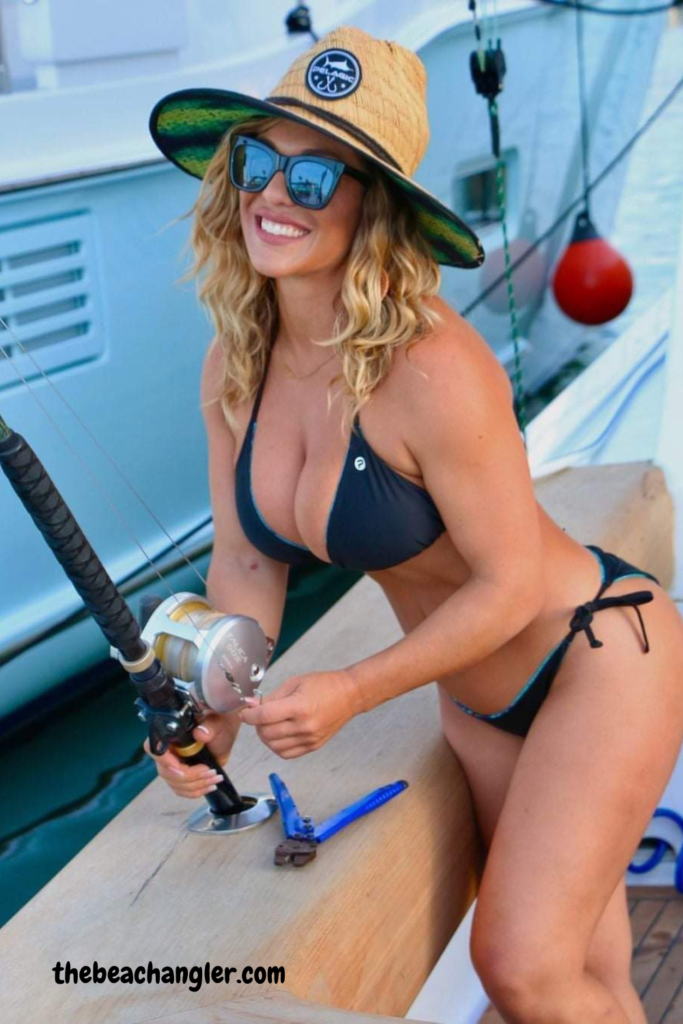
As always, stay safe, enjoy the journey and please try to leave it cleaner than you found it. If you have any comments, questions, ideas or suggestions please leave them in the comment section below and I’ll get back to you asap. You can follow us on Facebook: Rex The Beach Angler, Instagram: thebeachangler7, Twitter: @AnglerBeach, and YouTube: Man Art Creations.
P.S. – Thanks so much for checking out our blog we really appreciate it. Just so you know, we may receive a commission if you click on some of the links that appear on our site. This helps us keep our content free and up-to-date for everyone. We appreciate your support!

A life long surf fisherman with 50+ years of experience, I am also an avid hunter and outdoorsman. I will be sharing my passion for the outdoors with you so be prepared for hunting, fishing, camping, hiking and more. Along with gear reviews and the latest trends and innovations in the outdoor industry.
